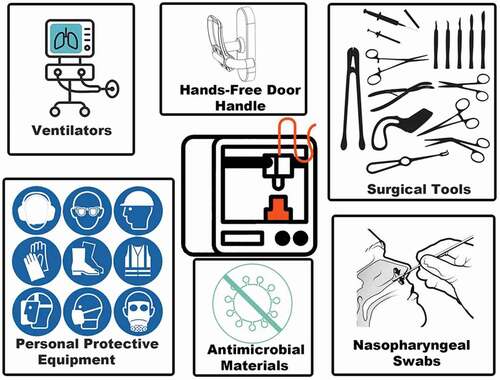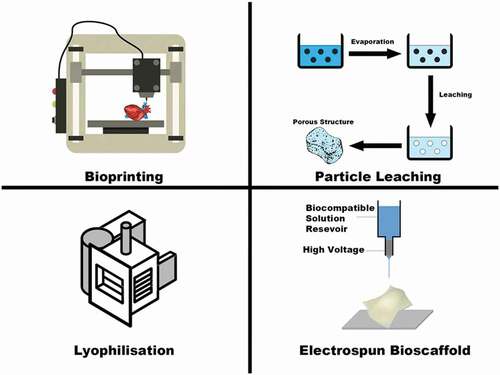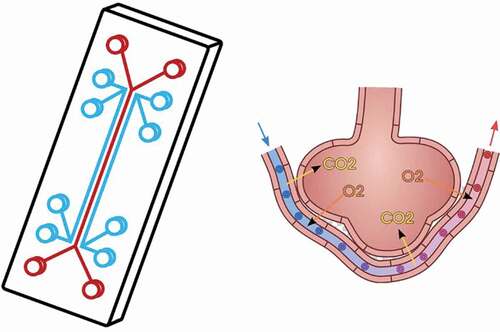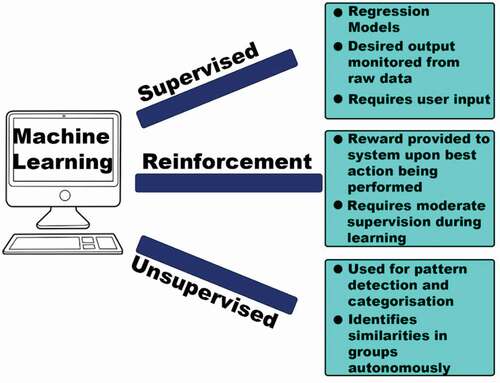ABSTRACT
Introduction
Covid-19, alongside previous pandemics, has highlighted the need for the continued development of technologies that are at our disposal. Emerging technologies are those that show true promise in achieving such a goal and have begun to form sturdy independent research areas. Technological advances in healthcare must continually develop to ensure that the world is prepared for any future diseases that may ensue. As such, a strategic review into 43 manuscripts since 2019 has been conducted to determine the prominence of emerging technologies since the beginning of the Covid-19 pandemic.
Areas Covered
Relating to their use in a pandemic state, additive manufacturing (AM), biofabrication, microfluidics, biomedical microelectromechanical systems (BioMEMS), and artificial intelligence (AI) are described. Applications over the past 2–3 years, as well as future developments, are considered throughout.
Expert Opinion
All the technologies mentioned in this review are sure to develop further, having shown their importance and value during the covid-19 pandemic. As research continues within the area, their efficacy will increase to the point where it likely will become gold standard for pandemic control. Combining certain technologies mentioned has also proved to have had great success in improving the final results obtained.
1. Introduction
As defined by the World Health Organization (WHO), a pandemic is a disease that spreads and has a subsequent impact on a global scale [Citation1]. The most potent and recent example of which is the SARS-CoV-2 virus (COVID-19 pandemic), which has contributed to reshaping the world perception on the requirement for modern solutions to provide protection against such events. Past notable pandemics include the Spanish flu H1N1, 1918, infecting a third of the world’s population and claiming the lives of approximately 50 M people [Citation2], or the Asian Flu H2N2, 1957–1958, causing 1.1 M deaths [Citation3]. Whilst the current number of infections and deaths relating to covid-19 continues to rise, it’s clear that barriers must be developed for the future, to limit the strain caused by pandemic diseases. Emerging technologies within the healthcare sector are examples of contemporary advancements designed with the intention of achieving such goals when implemented for specific uses. As is the case for infectious diseases, prevention and diagnosis can frequently be just as important as the therapeutic aspect, hence all characteristics must be considered to provide an effective encompassing treatment plan. Discussed within this review are a variety of emerging technologies (ET), such as additive manufacturing (AM), biofabrication, Microfluidics (MFs), biomedical microelectromechanical systems (BioMEMS) and artificial intelligence (AI), and how they are being utilized in the fight against both covid-19 and for any future pandemics that may arise.
2. Review methodology and search criteria
Terms relating directly to the subcategory headings in section 3 were targeted, most notably from credible journal sources such as Scopus (Elsevier) and Core Collection (Thomson Reuters). Articles preceding the year of 2019 were excluded from search results. Full text shifts were performed by the authors upon selection to ensure sufficient quality for review and subsequent inclusion.
3. Emerging technologies
3.1. Additive manufacturing
AM, also known as 3D printing (3DP), allows the production of highly specific and customizable medical devices for a multitude of applications. Specifically for combating pandemics, 3DP has been applied to the production of unique personal protection equipment incorporated with novel antimicrobial properties [Citation4,Citation5]. As witnessed during the covid-19 pandemic, supply chains were highly impacted due to severe travel restriction implementations. AM negates the need for such supply chains by allowing the production of complex medical equipment including ventilators, nasopharyngeal swabs, and surgical tools ‘in-house’ () [Citation6–8].
The feasibility for AM to be implemented against pandemics is due to the reduced cost and increased use of the technology worldwide [Citation9]; the parallel enhancement of remote connectivity also bolsters the impact that the technology can have. When an internet connection is available, computer aided design (CAD) files can be accessed across the globe at will, meaning that designs can be made available to those even without the skill of constructing the original blueprint [Citation10]. The compatibility of AM with a wide range of antimicrobial polymers, including cellulose and polyethylene glycol dimethacrylate (PEGDMA), has reduced the risk of spreading the disease by stopping the object acting as a fomite. Whilst pandemic related diseases such as coronaviruses are often considered primarily to be airborne diseases, the impact that fomites have on the spread is non-negligible [Citation11]. Microneedles (MNs) are an effective and painless way to deliver medicines via the transdermal route to achieve a therapeutic effect. Production of MNs via AM is quickly becoming the gold standard of production methods to fabricate MN patches of various types, due to the optimization of printing parameters [Citation12]. MNs are capable of delivering vaccines, especially lipid-based vaccines, as will be discussed further in section 2.3. MF chips can also be easily and efficiently produced using AM and can be designed to desired specifications. Several methods of manufacture, using different materials and printers have already been established to achieve this purpose [Citation13,Citation14]; the choice of which relies upon the intended use of the chip, for example whether it’s being used for analysis or formulation.
3.2. Biofabrication
Biofabrication entails the construction of objects and systems using biological materials [Citation15]. Often associated with tissue engineering (TE) and regenerative medicine (RM), biofabrication marks a pivotal step toward understanding the synthesis of biological systems from raw materials in a ‘bottom-up’ approach. Whilst biofabrication and bioprinting are technically separate entities, their use within literature overlaps to the point where they are often used interchangeably [Citation15]. Biofabrication is associated with AM via the use of bioprinters, to print cells and tissues for the purpose of drug discovery, tissue research and tissue/organ transplantation. For the treatment of covid-19, a disease which primarily affects the respiratory system, biofabricated 3D lung models were proposed to assist in identifying drug targets relevant for 3D printing [Citation16]. Alternative forms of biofabrication that exist are solvent casting, freeze-drying (lyophilization), and electrospinning scaffolds () [Citation17]. Biofabrication helps reduce the need for experiments on living animals by providing a more accurate environment in a laboratory setting than what is achievable with simple cell cultures.
3.3. Microfluidics & nanofluidics (NFs)
MFs has theranostic applications that can be exploited for the suppression of pandemics. The precise control of liquid media within a confined volumetric area lends itself to achieving a wide range of actions, for example formulation of lipid-based vaccines. siRNA vaccines, as produced by various companies (e.g. Pfizer, AstraZeneca) to combat covid-19, have become a topic of great interest due to their flexibility, stability, and efficacy [Citation18]. Research into the formulation of biologics, including mRNA and siRNA, within liposomal carriers using MFs is a novel method that’s gaining much traction at the moment due to the quality of results being seen [Citation19,Citation20]. In-depth reviews into the use of mRNA as a vaccine platform for covid-19 have been conducted by Forchette et al. [Citation21] and Szabó et al. [Citation22]. The liposomal vaccine can then be formulated using MFs and administered via MNs, as mentioned in section 2.1.
Both MFs and NFs have applications in rapid antigen detection and diagnosis. This has already been applied for the detection of the SARS-Cov-2 antigen [Citation23,Citation24], but due to the customizable nature of the technology, could be adapted to provide accurate and quick detection for biomarkers in future pandemics. MFs is known to be a fast process due to its confined area [Citation25], allowing rapid diagnosis; this is especially important for pandemics owing to the vast number of infections that may be present. MF technology has been adapted to allow for point of care (PoC) testing, as many devices now don’t require external power sources to function, for example in paper MFs [Citation26]. Ultrafast PCR using paper MFs has been investigated in depth relating to its future diagnostic potential [Citation27,Citation28].
Pandemics often occur due to a lack of effective active pharmaceutical ingredients (APIs) available to treat the disease. MFs provides a platform for rapid drug screening, otherwise known as high throughput screening, to determine in vitro efficacy, via lab-on-a-chip and organ-on-a-chip technology [Citation29,Citation30]. MFs provides organ-on-a-chip technology by the customization of the chip to simulate animal internal environments, as seen in . This technology can be performed in a continuous fashion, allowing for large amounts of proposed compounds to be tested in a limited amount of time.
3.4. BioMEMS
BioMEMS allow for the detection of specific biomarkers present in samples, both within a laboratory environment, but also at the PoC. When used in combination with MNs, BioMEMS devices allow for continuous monitoring and therapy of a disease [Citation31]. MN-BioMEMS combinations can be placed into the dermal layer to detect the presence of a pathogen in either blood, sweat or interstitial fluid (ISF). The BioMEMS can then cause the release of a medicine from the MN to suppress the disease ().
Figure 4. Drug loaded MN fitted with a BioMEMS capable of monitoring in vivo conditions and reacting to the stimuli accordingly.
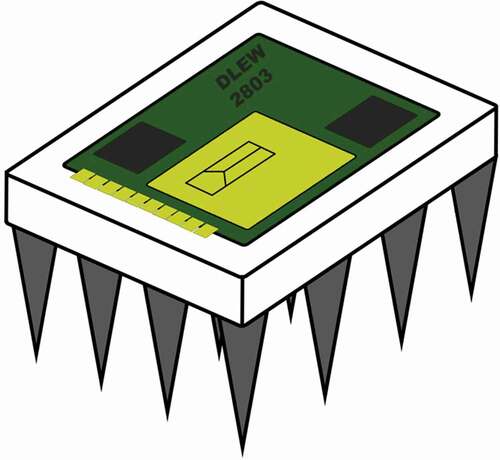
Microelectricalmechanical systems (MEMS) can be incorporated into a variety of devices with the assistance of AM, to achieve a multifunctional drug delivery system (DDS), to act for a specifically required role. This has been achieved in multiple cases, although some of the most pertinent examples for the treatment of pandemic related illnesses would relate to drug-eluted implantable devices fitted with BioMEMS to provide a comprehensive detection and treatment plan [Citation32]. The mechanical resonance of the MEMS is altered upon contact with a specifically predetermined protein/antibody, allowing for an automatically generated response [Citation10]. BioMEMS have been integrated within personal protective equipment (PPE), to allow for the early detection of viral droplets [Citation33], providing near instantaneous feedback to the wearer about recent contact with the disease. This would allow areas to be promptly sterilized and subsequently quarantined, without the need for further analysis, reducing the spread of a pandemic. Compatibility of BioMEMS with smart devices, e.g. smartphones also enables the emergence of a personalized technology [Citation34].
BioMEMS, whilst still being in relatively early stages of development, have been shown to display high degrees of selectivity for viral detection [Citation35], a feature which has proven to be an essential factor to reduce the number of false positive/negative results during diagnosis.
3.5. Artificial intelligence & machine learning (ML)
The emergence of AI has given rise to the possibility for the progression of technology and knowledge beyond what was ever previously fathomable. AI autonomously analyses patterns and external stimuli, which allows the prediction of the development of a disease [Citation36]. AI can be implemented for disease tracking in various ways: clinical symptom interpretation, disease monitoring, contact tracing, case/spread predictions and drug development [Citation37]. Diagnostically, AI has been implemented to assist with the assessment of the efficacy of vaccination [Citation38], specifically for covid-19, although this technology could be applied for multiple other future vaccines. All factors listed contribute heavily to the overall impact of a pandemic and all of which can be facilitated by the development of an AI system. The introduction of a competent AI programme will alleviate the requirement of human input, leaving more resources for physical tasks such as treating the disease. AI has been heavily involved in the contact tracing element of the covid-19 pandemic, from contact prediction resolution to analysis of opinions from social media [Citation39]. This helped provide protection to the population, whilst also presenting information on the progression of the pandemic to the masses. This ties into the innately technologically bound generation that currently exists.
Machine learning (ML), a sub-sector of AI, is especially prominent within the healthcare industry. ML is further subdivided into sections () including supervised, unsupervised and reinforcement learning [Citation40], all of which can be applied within the healthcare sector to fight against pandemics. ML can be implemented to assist with constructing designs for AM, to optimize printing parameters, ensuring the printed device can function to high standards of efficacy [Citation41]. This is achieved via the input of a multitude of iterations of designs and constructs within the CAD software, followed by subsequent prediction of printing success.
4. Conclusion
As seen throughout the article, all ETs mentioned have an intrinsic link to their capacity to deal with a pandemic. There is a dire need for all areas of healthcare to continue developing to help cope with future pandemics and the technologies in this review may come to be at the forefront of such development. With the accessibility increasing and the cost steadily decreasing for new technologies, positive research results are likely to transpire, which will only increase the knowledge pool globally. The areas of AM, MFs and AI have already gained so much traction within the last 2–3 years for their influence within healthcare in general. As seen throughout, as well as the summary provided in , their uses specifically for pandemic control are also increasing, which a soothing is thought for future generations.
Table 1. Summary of the highlighted uses of ETs for combating pandemics.
5. Expert opinion
The impact of a pandemic can often be devastating worldwide, but it can often be a stimulus or driving factor for concentrated work to help prevent such future events. As has been seen during the covid-19 pandemic, many collaborations were rapidly formed out of necessity, and it has shown to the scientific community what can be achieved when working with unity. Advancements in technological connectivity has allowed information to be spread rapidly across the globe, without the need for physical interaction. These factors facilitated the production and distribution of a novel vaccine against the newly emerged covid-19 virus, taking just 65 days for the first vaccine candidate to enter human trials from the initial outbreak publication [Citation42].
Originally, traditional response measures were followed to combat the initial outbreak of covid-19, such as lateral flow immunoassays and standard polymerase chain reaction (PCR) tests, due to their relatively cheap costs and our greater understanding of their working. It was soon realized the impact that could be achieved using the emerging technologies mentioned throughout this review, to produce and improve the facilities that were already available to combat the outbreak of a pandemic. The practice of AM, having increased in popularity and accessibility, became an essential technology for avoiding supply chain issues for many practices [Citation43]. The improvement in its functionality has led to the ability to produce designs that are more complex over a wider range of materials, and the capacity to produce PPE internally allowed many healthcare settings to continue operations with a greatly reduced risk.
In terms of future areas for combating pandemics, MFs appears to provide a wide range of functionality, possessing both diagnostic and formulation attributes. Growing expertise within this faculty is sure to aid with any future pandemics to come. The success of the covid-19 liposomal-based vaccine, coupled alongside the compatibility of producing such formulations using MFs, is sure to bring much research interest within this area in coming times. The speed and accuracy of biomarker detection using MFs will also be explored further, potentially to the point where it becomes a standard assay for pathogen detection globally.
Interweaving the ET above also provides exciting results, for example applying ML to produce a BioMEMS MN using AM. It’s the case that when combining new available technologies, the overall result produced may be of better quality than by using just one technology alone. AI and ML are becoming prominent already in many fields other than for healthcare, so it’s expected that they will assist in the development of future technologies beyond what we believe is possible currently.
As suggested by the name, all these technologies are relatively new, and have by no means peaked in their capabilities. Constant progress is forced upon the scientific community by consistent illnesses, sporadic pandemics, and the factor of human’s natural quest for knowledge. Hence, it’s likely that by the time of the next pandemic, these fields will have developed to be common practice in the struggle to suppress any negative effects posed by such an event.
Article highlights
Key points that must be addressed to suppress a pandemic.
The impact additive manufacturing is having on supply chains, personal protective equipment, and medical devices.
Applications of microfluidics for both formulation and diagnostic purposes.
Biomedical microelectromechanical systems and their importance for pathogenic sensing.
Artificial intelligence, especially machine learning, and its importance during the covid-19 pandemic.
Abbreviations
AM = Additive Manufacturing
3DP = 3d Printing
ET = Emerging technology
MFs = Microfluidics
BioMEMS = Biomedical microelectromechanical system
AI = Artificial Intelligence
ML = Machine Learning
CAD = Computer aided design
MN = Microneedle
TE = Tissue Engineering
RM = Regenerative Medicine
PoC = Point of care
PPE = Personal protective equipment
Declarations of interest
Shahid Uddin is an employee of Immunocore. The authors have no other relevant affiliations or financial involvement with any organization or entity with a financial interest in or financial conflict with the subject matter or materials discussed in the manuscript. This includes employment, consultancies, honoraria, stock ownership or options, expert testimony, grants or patents received or pending, or royalties.
Reviewers disclosure
Peer reviewers on this manuscript have no relevant financial relationships or otherwise to disclose.
Additional information
Funding
References
- Grennan D. What is a Pandemic? Jama. 2019;321(9):910.
- Shilpa K, Kumar S, Ugargol A, et al. A study on awareness regarding swine flu (influenza A H1N1) pandemic in an urban community of Karnataka. Med J Dr DY Patil University. 2014;7(6):732.
- Poudel PB, Poudel MR, Gautam A, et al. COVID-19 and its global impact on food and agriculture. J Biol Today’s World. 2020;9(5): 221–225
- Rendeki S, Nagy B, Bene M, et al. An overview on personal protective equipment (PPE) fabricated with additive manufacturing technologies in the era of COVID-19 pandemic. Polymers. 2020;12(11):2703.
- Wierzbicki J, Nowacki M, Chrzanowska M, et al. Additive manufacturing technologies enabling rapid and interventional production of protective face shields and masks during the COVID-19 pandemic. Adv Clin Exp Med. 2020;29(9):1021–1028.
- Arora PK, Arora R, Heleem A, et al. Application of additive manufacturing in challenges posed by COVID-19. Mater Today Proc. 2021;38:466–468.
- Kunovjanek M, Wankmüller C. An analysis of the global additive manufacturing response to the COVID-19 pandemic. J Manuf Technol Manage. 2020;32(9): 75–100.
- Tareq MS, Rahman T, Hossain M, et al. Additive manufacturing and the COVID-19 challenges: an in-depth study. J Manuf Syst. 2021;60:787–798.
- Longhitano GA, Nunes GB, Candido G, et al. The role of 3D printing during COVID-19 pandemic: a review. Prog Addit Manufact. 2021;6(1):19–37.
- Lamprou DA. Emerging technologies for diagnostics and drug delivery in the fight against COVID-19 and other pandemics. Expert Rev Med Devices. 2020;17(10):1007–1012.
- Chaudhuri S, Saha A, Basu S. An opinion on the multiscale nature of Covid-19 type disease spread. Curr Opin Colloid Interface Sci. 2021;54:101462.
- Mathew E, Pitzanti G, Gomes Dos Santos AL, et al. Optimization of printing parameters for digital light processing 3D printing of hollow microneedle arrays. Pharmaceutics. 2021;13(11):1837.
- Ballacchino G, Weaver E, Mathew E, et al. Manufacturing of 3D-printed microfluidic devices for the synthesis of drug-loaded liposomal formulations. Int J Mol Sci. 2021;22(15):8064.
- Weisgrab G, Ovsianikov A, Costa PF. Functional 3D printing for microfluidic chips. Adv Mater Technol. 2019;4(10):1900275.
- Groll J, Boland T, Blunk T, et al. Biofabrication: reappraising the definition of an evolving field. Biofabrication. 2016;8(1):013001.
- Singh AK, Mishra G, Maurya A, et al. Biofabrication: an interesting tool to create in vitro model for COVID-19 drug targets. Med Hypotheses. 2020;144:110059.
- Bajaj P, Schweller RM, Khademhosseini A, et al. 3D biofabrication strategies for tissue engineering and regenerative medicine. Annu Rev Biomed Eng. 2014;16:247–276.
- Sajid MI, Moazzam M, Cho Y, et al. siRNA therapeutics for the therapy of COVID-19 and other coronaviruses. Mol Pharm. 2021;18(6):2105–2121.
- Shepherd SJ, Warzecha CC, Yadavali S, et al. Scalable mRNA and siRNA lipid nanoparticle production using a parallelized microfluidic device. Nano Lett. 2021;21(13):5671–5680.
- Weaver E, O’Connor E, Cole DK, et al. Microfluidic-mediated self-assembly of phospholipids for the delivery of biologic molecules. Int J Pharm. 2022;611:121347.
- Forchette L, Sebastian W, Liu T. A comprehensive review of COVID-19 virology, vaccines, variants, and therapeutics. Curr Med Sci. 2021;41(6):1037–1051.
- Szabó GT, Mahiny AJ, Vlatkovic I. COVID-19 mRNA vaccines: platforms and current developments. Mol Ther. 2022;30(5):1850–1868.
- Dong X, Liu L, Tu Y, et al. Rapid PCR powered by microfluidics: a quick review under the background of COVID-19 pandemic. TrAC Trends Analyt Chem, 2021:116377. DOI:10.1016/j.trac.2021.116377.
- Hsieh H-Y, Luo J-X, Shen Y-H, et al. A nanofluidic preconcentrator integrated with an aluminum-based nanoplasmonic sensor for Epstein-Barr virus detection. Sens Actuators B Chem. 2022;355:131327.
- Jiang K, Jokhun DS, Lim CT. Microfluidic detection of human diseases: from liquid biopsy to COVID-19 diagnosis. J Biomech. 2021;117:110235.
- Gong F, Wei H-X, Qi J, et al. Pulling-force spinning top for serum separation combined with paper-based microfluidic devices in COVID-19 ELISA diagnosis. ACS Sens. 2021;6(7):2709–2719.
- You M, Li Z, Feng S, et al. Ultrafast photonic PCR based on photothermal nanomaterials. Trends Biotechnol. 2020;38(6):637–649.
- Li F, You M, Li S, et al. Paper-based point-of-care immunoassays: recent advances and emerging trends. Biotechnol Adv. 2020;39:107442.
- Ramezankhani R, Solhi R, Chai YC, et al. Organoid and microfluidics-based platforms for drug screening in COVID-19. Drug Discov Today. 2021;27(4):1062–1076.
- Phan DT, Wang X, Craver BM, et al. A vascularized and perfused organ-on-a-chip platform for large-scale drug screening applications. Lab Chip. 2017;17(3):511–520.
- Lamprou DA. Emerging technologies in the delivery of proteins and peptides. Bioprocess Online. 2021. Available from: https://www.bioprocessonline.com/doc/emerging-technologies-in-the-delivery-of-proteins-peptides-0001
- Chin SY, Poh YC, Kohler A-C, et al. Additive manufacturing of hydrogel-based materials for next-generation implantable medical devices. Sci Rob. 2017;2(2):eaah6451.
- Abdullah, Rasheed A, Adnan Y, et al. Wearable Piezoelectric BioMEMS-based Sensor for SARS-CoV-2 (COVID-19) Virus Droplets Detection,” 2021 IEEE 15th International Conference on Nano/Molecular Medicine & Engineering (NANOM. 2021 IEEE 15th International Conference on Nano/Molecular Medicine & Engineering (NANOMED). IEEE; 2021. p. 34–37 DOI:10.1109/NANOMED54179.2021.9766767
- Mujawar MA, Gohel H, Bhardwaj SK, et al. Nano-enabled biosensing systems for intelligent healthcare: towards COVID-19 management. Mater Today Chem. 2020;17:2468–5194.
- Çağlayan Z, Demircan Yalçın Y, Külah H. A prominent cell manipulation technique in bioMEMS: dielectrophoresis. Micromachines. 2020;11(11):990.
- Bragazzi NL, Dai H, Damiani G, et al. How big data and artificial intelligence can help better manage the COVID-19 pandemic. Int J Environ Res Public Health. 2020;17(9):3176.
- Vaishya R, Javaid M, Khan IH, et al. Artificial Intelligence (AI) applications for COVID-19 pandemic. Diabetes Metab Syndr. 2020;14(4):337–339 .
- Tong H, Cao C, You M, et al. Artificial intelligence-assisted colorimetric lateral flow immunoassay for sensitive and quantitative detection of COVID-19 neutralizing antibody. Biosens Bioelectron. 2022;213:114449.
- Cresswell K, Tahir A, Sheikh Z, et al. Understanding public perceptions of COVID-19 contact tracing apps: artificial intelligence–enabled social media analysis. J Med Internet Res. 2021;23(5):e26618.
- Carleo G, Cirac I, Cranmer K, et al. Machine learning and the physical sciences. Rev Mod Phys. 2019;91(4). DOI:10.1103/RevModPhys.91.045002.
- Goh GD, Sing SL, Yeong WY. A review on machine learning in 3D printing: applications, potential, and challenges. Artif Intell Rev. 2021;54(1):63–94.
- Le TT, Cramer JP, Chen R, et al. Evolution of the COVID-19 vaccine development landscape. Nat Rev Drug Discov. 2020;19(10):305–306.
- Larrañeta E, Dominguez-Robles J, Lamprou DA. Additive manufacturing can assist in the fight against COVID-19 and other pandemics and impact on the global supply chain. 3D Print Addit Manuf. 2020;7(3):100–103.

